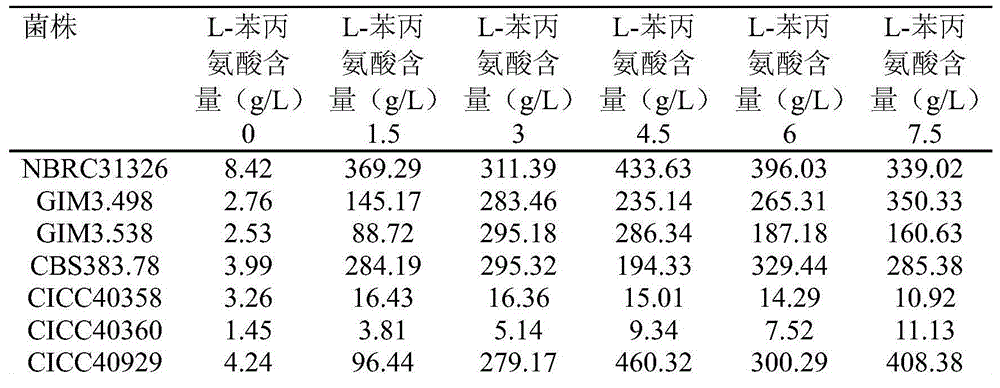Method of using trichoderma reesei to produce aromatic substance
A technology of Trichoderma reesei and fermentation substrate, which is applied in the field of production of β-phenylethanol and/or phenylacetaldehyde, and can solve the problem of limited initial raw materials for phenylethanol, high fermentation costs, and expensive L-phenylalanine raw materials, etc. problem, to achieve the effect of shortening the production time, diversifying the metabolic capacity, and growing without toxicity
- Summary
- Abstract
- Description
- Claims
- Application Information
AI Technical Summary
Problems solved by technology
Method used
Image
Examples
Embodiment 1
[0037] Example 1 Trichoderma reesei uses bran to produce β-phenylethanol
[0038] Fermentation medium (g / L): Bran 60 (Yihai Kerry (Kunshan) Food Industry Co., Ltd.), glucose 1, ammonium sulfate 1.84, yeast extract 0.5 (OXOID, catalog number LP0021), potassium dihydrogen phosphate 0.2, Magnesium sulfate heptahydrate is 0.5, calcium chloride dihydrate is 0.03, and the addition amount of L-phenylalanine is 0, 1.5, 3, 4.5, 6 and 7.5g / L, and the pH is natural.
[0039] The above-mentioned culture medium was divided into 250 mL shake flasks, 50 mL each, and sterilized at 115°C for 20 min.
[0040] Strain culture: 9 spores of Trichoderma reesei in Table 1 were respectively inoculated on PDA medium and cultured at 28°C for 7 days. PDA medium formula: boil 200g potatoes for half an hour, filter with 4 layers of gauze, and make 1 liter. After sterilization at 115°C, add 20 g of glucose.
[0041] Spore suspension preparation: The Trichoderma reesei strains cultured on the PDA culture plate fo...
Embodiment 2
[0050] Example 2 Trichoderma reesei uses defatted rice bran meal to produce β-phenylethanol
[0051] In order to further investigate the effect of using other cheap carbon sources to culture Trichoderma reesei to produce β-phenethyl alcohol, strains GIM3.498, GIM3.538, and CBS383.78 were randomly selected for fermentation on a medium using defatted rice bran meal as a carbon source.
[0052] Fermentation medium (g / L): defatted rice bran meal 60 (Yihai Kerry (Jiamusi) Grain and Oil Industry Co., Ltd.), glucose 1, ammonium sulfate 1.84, yeast extract (OXOID, catalog number LP0021) 0.5, potassium dihydrogen phosphate 0.2 , Magnesium sulfate heptahydrate 0.5, Calcium chloride dihydrate 0.03, L-phenylalanine addition amount 0, 1.5, 3, 4.5, 6 and 7.5, pH natural.
[0053] The above-mentioned culture medium was divided into 250 mL shake flasks, 50 mL per shake flask, and sterilized at 115°C for 20 min.
[0054] The experimental method is the same as in Example 1, except that the medium used...
Embodiment 3
[0062] Example 3 Fermentation using fermentation strain CICC40929 in 7.5L and 30L fermenters
[0063] Combined with Examples 1-2, we proved that CICC40929, BRC31326, GIM3.498, GIM3.538, CBS383.78, CICC40358, CICC40360, CICC41491, CICC41493 can produce β-phenylethanol at the shake flask level. Through Example 3, we further verified the ability of the Trichoderma reesei strain to produce phenylethanol at the fermenter level, where CICC40929 was randomly selected for fermentation in a 7.5-liter tank and a 30-liter tank. For the 7.5-liter fermentation tank experiment, the main carbon source used was bran; the 30-liter fermentation tank used glucose as the carbon source.
[0064] (1) Fermentation culture of CICC40929 in a 7.5L tank
[0065] Fermentation medium
[0066] Fermentation seed medium (g / L): malt extract 20, glucose 20, ammonium sulfate 1.84, yeast extract 0.5, potassium dihydrogen phosphate 0.2, magnesium sulfate heptahydrate 0.5, calcium chloride dihydrate 0.03, natural pH
[0...
PUM
 Login to View More
Login to View More Abstract
Description
Claims
Application Information
 Login to View More
Login to View More - R&D
- Intellectual Property
- Life Sciences
- Materials
- Tech Scout
- Unparalleled Data Quality
- Higher Quality Content
- 60% Fewer Hallucinations
Browse by: Latest US Patents, China's latest patents, Technical Efficacy Thesaurus, Application Domain, Technology Topic, Popular Technical Reports.
© 2025 PatSnap. All rights reserved.Legal|Privacy policy|Modern Slavery Act Transparency Statement|Sitemap|About US| Contact US: help@patsnap.com



